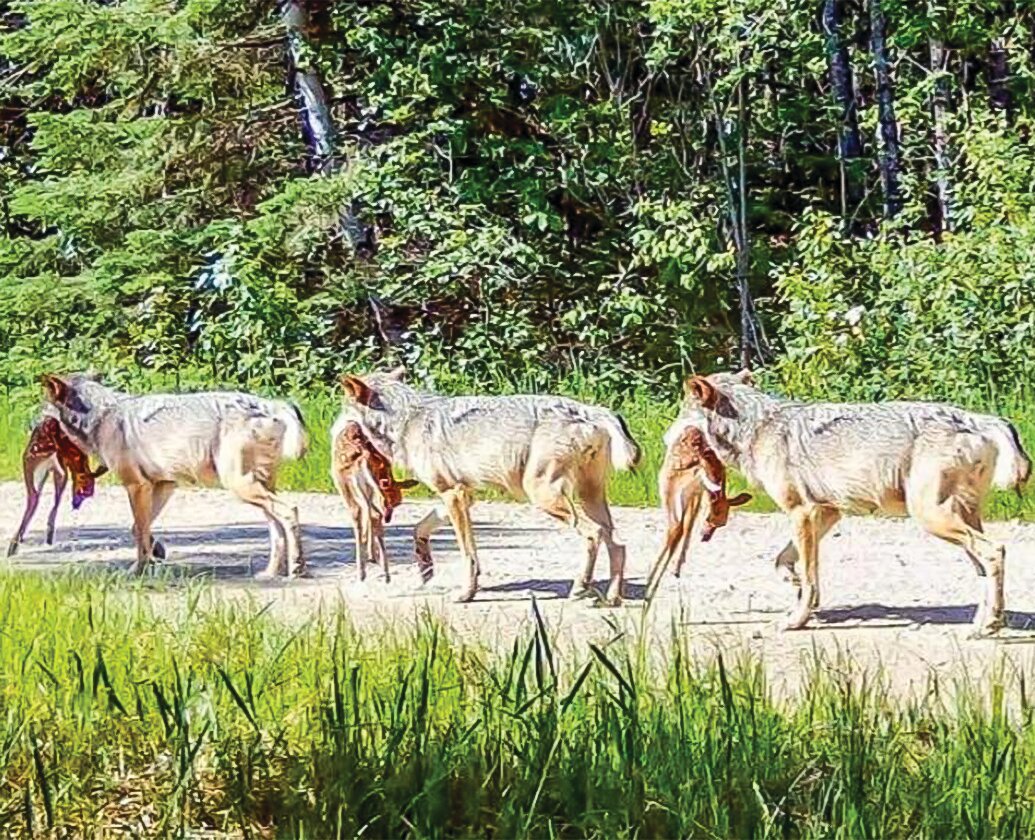Support the Timberjay by making a donation.
Study: Human impacts may be helping wolves hunt
Finds that roads, trails, and logging are making fawns more susceptible to predation
REGIONAL— Humans have significantly altered the landscape of northeastern Minnesota and those changes appear to be helping wolves prey more effectively on whitetailed deer and their fawns. …
This item is available in full to subscribers.
Attention subscribers
To continue reading, you will need to either log in to your subscriber account, below, or purchase a new subscription.
Please log in to continue |
Study: Human impacts may be helping wolves hunt
Finds that roads, trails, and logging are making fawns more susceptible to predation
REGIONAL— Humans have significantly altered the landscape of northeastern Minnesota and those changes appear to be helping wolves prey more effectively on whitetailed deer and their fawns. That’s the conclusion of new research from the Voyageurs Wolf Project which was recently published in the journal Ecological Applications.
“The premise is really quite simple,” said Dr. Thomas Gable, a postdoctoral researcher at the University of Minnesota and co-lead author of the study. “Human activities change where deer are on the landscape, and wolves go where the deer are. Plus, humans have done an excellent job of creating and maintaining a diverse, well-connected web of roads, trails, and other cleared linear features that are ideal corridors for wolves to hunt deer,” said Gable.
From logging to the creation of roads and trails and other infrastructure, like power lines, humans have fundamentally reshaped where wolves hunt and kill deer fawns, according to the research.
Most logging in northern Minnesota involves clear-cutting forests. After forests have been cleared, dense stands of young saplings provide prime food for deer and provide excellent hiding spots for newborn fawns. However, wolves seem to know that these recently-logged areas are good hunting spots, turning these nursery grounds into risky areas for deer fawns during summer, according to the research.
“Our work indicates wolves disproportionately hunt and kill deer fawns around recently logged areas—those that have been logged within the past five years,” said Gable, “but not areas that have been logged more than five years ago. This is likely because clear-cut forests are much better deer habitat for the first few years, when new growth is available for browsing, than several years later when most potential browse has grown out of reach.
However, it’s not just logging that influences where wolves hunt and kill deer fawns.
“Surprisingly, wolves tend to kill deer fawns closer to human infrastructure, like cabins, year-round residences, and barns, than expected,” said Sean Johnson-Bice, a PhD candidate from the University of Manitoba and co-lead author of the study. Because wolves are afraid of people, prey in some areas have learned to congregate around humans to avoid the predators.
But it appears wolves are more willing to come into more human-dominated areas to hunt fawns. And the congregation of deer around people might have less to do with avoiding predators and more to do with getting food. Supplemental feeding of deer is common in the region, and this likely congregates deer near human-developed areas.
“Although the high concentration of deer near human development attracts wolves to areas near people, wolves still definitely avoid encountering people when hunting fawns around human infrastructure,” said Austin Homkes, a researcher for the Voyageurs Wolf Project and co-lead author of the study. “Wolves spend substantial time in close proximity to occupied cabins and residences, and yet almost no one sees them.”
In a related study, the researchers also found that roads, powerlines, ATV trails, and hunting lanes in rural areas often act as hunting highways for wolves. Wolves can travel faster and farther along these linear features compared to traveling in the dense forests of northern Minnesota. In turn, these features appear to increase wolf hunting efficiency by allowing wolves to cover a larger area more effectively while burning fewer calories.
“Wolves face the same general issues that people do when traveling in the woods, and just like humans, wolves often prefer to travel on linear corridors like roads and trails rather than bushwhacking through the dense forest,” said Dr. John Bruggink, a professor at Northern Michigan University, and a co-author of the study.
Thus, it came as no surprise to the research team that wolves preferentially hunted fawns from these linear features and disproportionately killed fawns closer to these features than would be expected.
“When we put all of the pieces together, it is pretty clear that the cumulative effects of all major aspects of human activity in the Northwoods – logging, infrastructure development, and road/trail development – have fundamentally changed where and how wolves hunt deer fawns here,” adds Johnson-Bice. “The rules of this predator-prey game change when people alter ecosystems, and it’s possible we have created conditions that may have tipped the scales in the predators’ favor.”
The study was conducted by a collaborative team of researchers from the University of Minnesota, Northern Michigan University, Voyageurs National Park, and the University of Manitoba.
The Voyageurs Wolf Project is funded, in part, by the Minnesota Environment and Natural Resources Trust Fund as recommended by the Legislative-Citizen Commission on Minnesota Resources (LCCMR).






